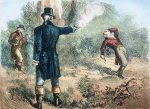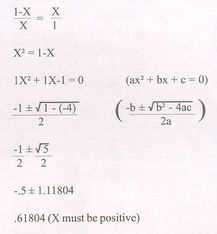By Tweed
In my last post on the Constitution, I briefly described the history of the adoption of the Constitution. In this post I will briefly describe how the Constitution found its biological parents.
The Constitution is chock full of nifty concepts and rules. There is the "balance of power" concept, the "checks and balances" concept and the "Great Sandini Balancing Act" concept. All of these concepts are buried deep within the text of the Constitution, which has guaranteed their departure into the world of irrelevance and obscurity.
Welcome to the World of Irrelevance and Obscurity.
Part I - The Executive BranchThe Executive Branch of the Federal government is described in Article II of the Constitution, but it has nicer bathrooms than the branch of government described in Article I. Article II provides that the executive power of the United States is vested in the President. This gives the President the authority to enforce the laws of the country, spare one Turkey from the oven each Thanksgiving and not get out of bed to go to work.
The President is empowered to make deals with foreigners, subject to Senate approval. This makes the United States a lot like that nerdy kid you grew up with who had to check with his mom before he could do anything (and she usually said no). Historically, presidents have attempted to circumvent Senate oversight, usually without much success. In 1852, for example, President Filmore tried to enter a trade pact with Spain by pretending to be sick and signing the pact when the Senate went to work that morning. But the Senate found out that evening, and punished the President by re-naming him Millard. Over time, presidents have gained the trust of the Senate, which has rewarded the president with greater freedom of action in foreign affairs under special circumstances, such as when Britney Spears is performing at the Albert Hall.
There's also a Vice President, who gets to bust prostitutes and gamblers.
Part II - The Legislative BranchThe Legislative Branch is described in Article I of the Constitution and consists of two houses, both alike in dignity, in swampy Washington, where we lay our scene. The House of Representatives is larger than the Senate, and consists of 439 representatives, 4,874 staffers and 25,773 interns. The House of Representatives is famous for being the only house of the Legislative Branch with the word "house" in its title. It also makes a great barbecue sauce.
The Senate, consisting of 97 Senators, 7,984 staffers and 487,933 interns, used to be the more dignified house, until the senior Senator from Ohio began making fart noises whenever his colleagues sat down. It is now considered to be closer alligned with the mood of the people.
The chief job of the legislative branch of government is to right the law - an important function, because the law is prone to frequent capsizing.
Part III - The Judicial BranchThe Judicial Branch of government is the Supreme Court and is described in Article III of the Constitution. The Supreme Court is the highest court in the land, which explains the massive orders for pizza and potato chips from the Supreme Court building. The Justices of the Supreme Court hold court in the their hands or in the Halls of Justice. The current members of the Supreme Court are Superman, Wonder Woman, Batman, Robin, Aqua Man, the Flash, the Green Lantern and the Wonder Twins.
The Supreme Court's function is to interpret the Constitution. This is a very difficult job, because there are many theories on how the Constitution should be interpreted. Conservatives generally prefer the Constitution with some fiddle and spoon slapping, while most liberals prefer a dance beat and some sythesizers. Strict constructionists prefer theirs with a strings and light woodwinds.
Part III - Make Law, Not WarCorrect me if I'm wrong, but both houses of the Legislative Branch must vote to pass a law. Every law starts as a bill, only a bill, sitting there on capital hill. Bills usually end up in committee, along with everything else known to humanity. Occasionally, some things pop out of committee - like yesterday, when old Ms. Schuyler's shawl that she lost on her trip to Washington back in 87' popped out of the House Sub-Committee on Frozen Waffles and Urban Infrastructure.
Once out of committee, everyone gets to attach ryders to a bill. By law, each ryder must (a) be wholly unrelated to the bill to which it is attached, and (b) be designed to either (i) destroy any chance the bill has in being approved or (ii) give a congressman's girlfriend $400,000 to build a beutician museum in downtown Akron. Once a bill is sufficiently weighted down with ryders (the Constitution requires at least 36 ryders), the bill is thrown into a large body of water, traditionally, the Potomac river. If it floats, it passes; but if it sinks, it was never a good idea to begin with.
If the bill floats, it is immediately presented to the President for drying. If the President likes the bill, he signs it and it becomes law. If he doesn't like it, he throws it back into the Potomac.
But here's the big problem: we have to wait for a controversy before the Supreme Court weighs in on any law's constitutionality. Here's an idea - what if Congress or the President could just ask before hand and save everyone some time?
Part IV - The Great Sandini Balancing ActThe founders of the Constitution understood the importance of balance. Accordingly, laying in wait for the unwary are a series of balancing acts.
Until the adoption of the 17th Amendment, the principle of the "balance of power" required that, at all times, the weight of the President and his cabinet had to be within five pounds of 75% of the aggregate weight of the members of the Supreme Court and within 15 pounds of the combined weight of the members of congress divided by 13 - which explains why Grover Cleveland's cabinet consisted of two midgets and a slight gay British national and Howard Taft's cabinet was made of balsa wood.* But this concept became cumbersome (no pun intended).
With the advent of the 17th amendment, the "balance of power" was dropped and quickly replaced by the "checks and balances" concept before anyone could get a good look at the Constitution naked. The checks and balances concept requires that upon assuming the office of President, the President's wealth must be equal to or greater than 40% of the wealth of the aggregate wealth of the members of the Supreme Court and equal to or less than the combined wealth of the five richest members of Congress. In the event that this requirement is not met, the President, members of the Supreme Court or members of Congress, as the case may be, write a series of checks until the proper balance is achieved (hence the name of the concept).
Tune in next time, as we discuss the Consitution's first date - the Bill of Rights.
* During Taft's tenure on the Supreme Court there was a mad rush to create additional cabinet posts to achieve balance, which explains the short lived, but much sought after post of Secretary of Chocolate Ice Cream.





